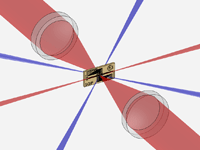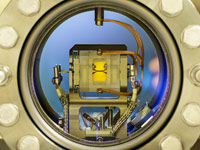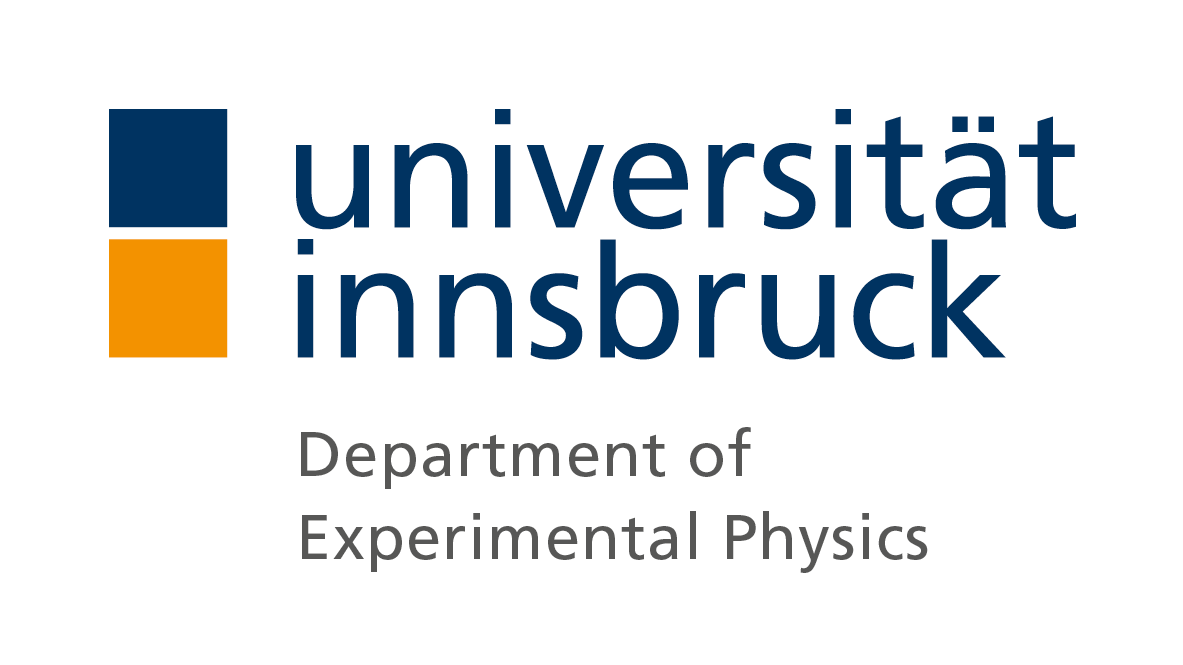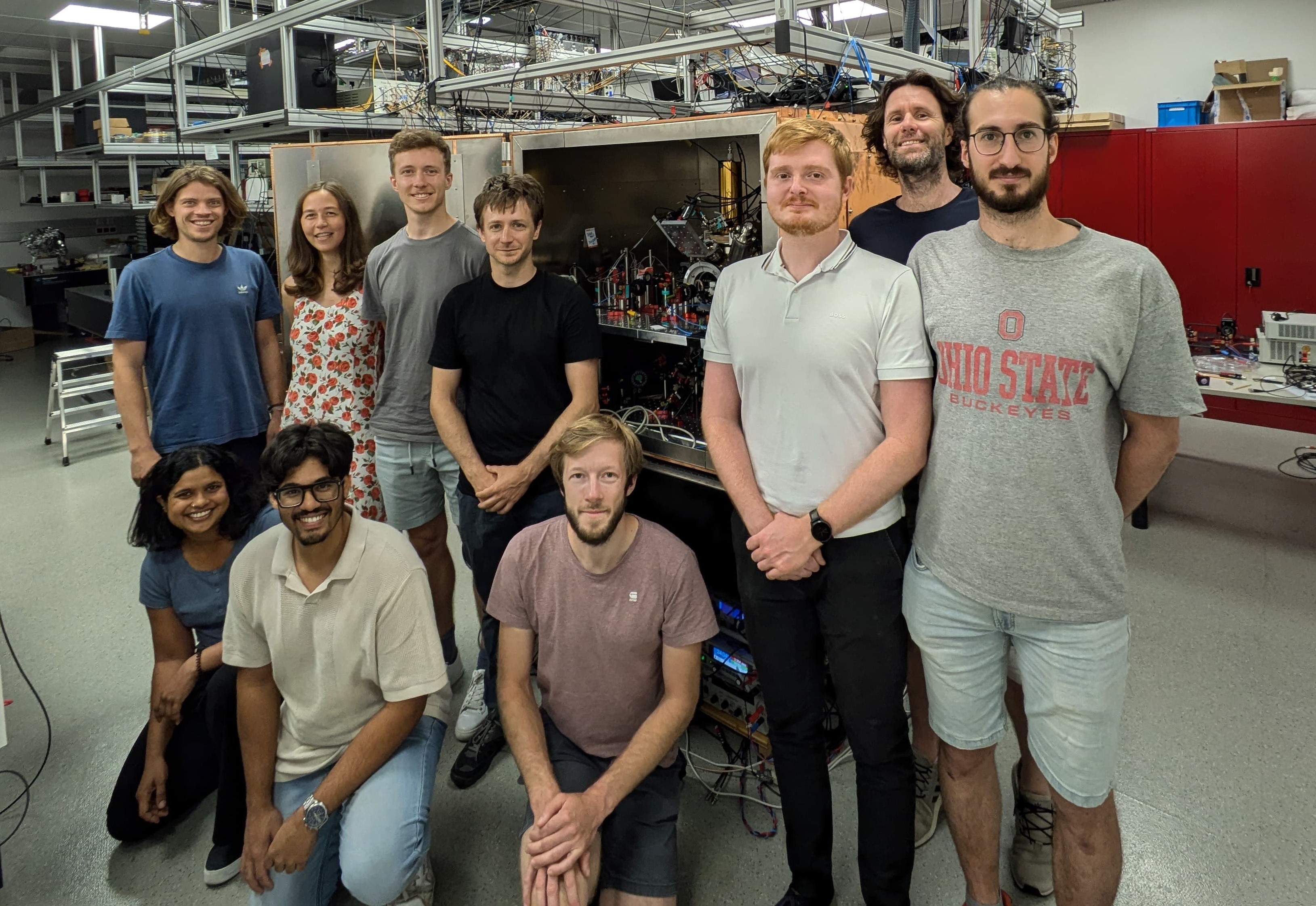News
- Details
Quantum Information beyond zero and one
Quantum information processing has evolved rapidly from rudimentary control over individual particles 25 years to performing complex calculations on sizable quantum registers today. Yet, despite fundamentally different working principles, much of the field builds on the decades-old paradigm of binary information processing. The underlying quantum information carriers, however, are inherently multilevel quantum systems. Our group aims to unlock the unused potential within today's quantum systems across a range of research directions, including:
- Quantum Information - How does the behaviour and the properties of quantum information change in higher dimensions?
- Quantum Computing - How can we use the full Hilbert space for more efficient quantum computing?
- Quantum Simulation - How can we simulate physical systems in the most natural and efficient way?
Our work has been kindly supported by many projects, including:
The EU programs: QUDITS, NeQST, TNiSQ
National excellence funding, including the FFG projects COMBINATION, and MUSIQ
Trapped Ion Qudit Platform
Trapped ions are among the leading platforms for quantum information processing. Using a combination of static and dynamic electric fields we trap and cool singly-charged atoms (ions) ultra-high vacuum (Fig.1). The electronic states of these ions are then used to store and process quantum information via laser pulses. Depending on the ion species, there may be tens of accessible, long-lived electronic states that can be controlled with exquisite precision. Our current platform uses Ca40, which has 8 states (Fig 2), of which only two are typically used for quantum information processing. In contrast to classical information, however, we cannot bunch these states together into a group that we call Zero and a group that we call One. Instead quantum control must work on each individual level and we pioneered the use of all of them for information processing using qudits instead of qubits (Nature Physics 18, 1053 (2022)). Beyond these basic building blocks, the ion-light interaction offers a wide range of possibilities that we explore for developing a flexible toolbox that can be configured for the optimal realization of a wide range of computational tasks (Nature Commun. 14, 2242 (2023)).


Fig 1.: Left: The ‘Linear trap’ original blade trap in use for two decades. Right: The modern successor trap AQT PINE as used in the QUDITS setup.
Quantum Information
In contrast to their binary counterpart, qudit systems are much richer in their Hilbert space structure. Much of the theoretical understanding that has been developed over the past years and decades does not generalize easily to qudits, leaving a wide range of open questions to be explored. We are particularly interested in studying fundamental properties including coherence (Physical Review X 8, 041007 (2018)) and entanglement (Quantum 7, 1141 (2023)), as well as quantum information primitives such as Clifford and Stabilizer structures that lay the groundwork for advanced protocols like quantum error correction and measurement-based computing.
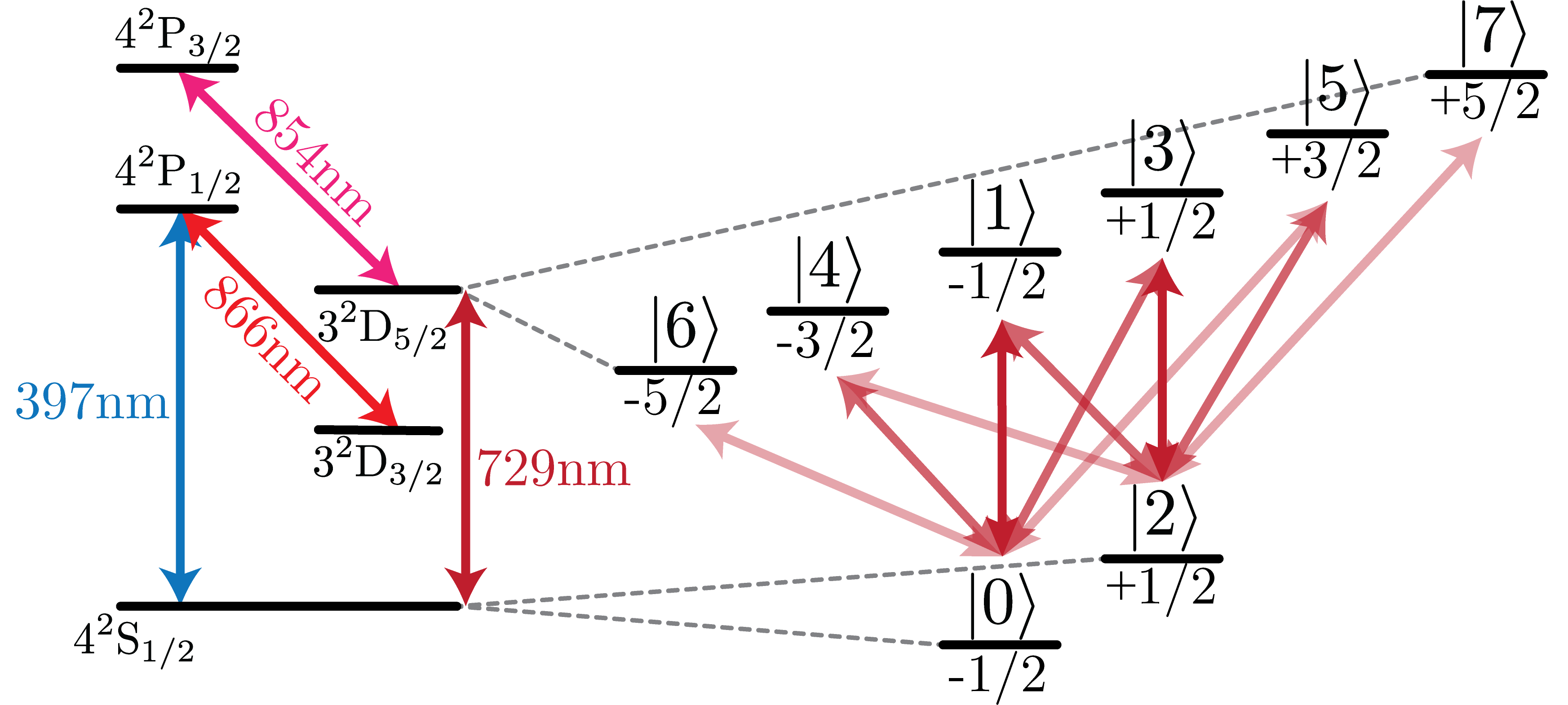
FIG 2: Level scheme of Ca-40: Already Ca-40, which is one of the simplest ions, offers 8 levels that can be controlled with exquisite precision.
Quantum Computing
Quantum computing has fundamentally changed how we think about information processing and opened a door to drastically more efficient computing for a certain class of problems. Yet, despite changing most rules of the game, we tend to stick to a binary format for the information that is processed. While this makes sense in the classical world, quantum systems are naturally suited for information processing using higher-valued logic. We are interested in two kinds of questions. On the one hand, we want to understand which computational problems benefit the most from a qudit approach and what design criteria drive the benefit of qudit quantum computing (Quantum 7, 1141 (2023)). On the other hand, we explore how the qudit Hilbert space can be used to enhance conventional qubit-based computing approaches (PRX Quantum 3, 040310 (2022), Physical Review X 12, 041035 (2022))
Quantum Simulation
One of the great promises of quantum computing is that it enables the efficient study of physical systems that are inaccessible to classical methods, such as aspects of chemistry, high-energy physics, and solid-state physics. Such systems are typically dominated by strong quantum effects, precluding classical simulation, and occupy high-dimensional Hilbert spaces. Hence, despite fundamental advantages of quantum simulation, realizing such simulations remains highly challenging when the simulator is limited to binary information processing. Using instead a platform that natively supports high-dimensional information processing enables the direct study of these models with vastly increased efficiency, thereby greatly expanding the reach of current and future quantum devices. We demonstrated this for archetypal examples in high-energy physics (arXiv:2310.12110 (2023)).
The Qudit team is always looking for Master’s students, PhD students, and postdocs! Do not hesitate to inquire with our principal investigator, Martin Ringbauer (
Project Members
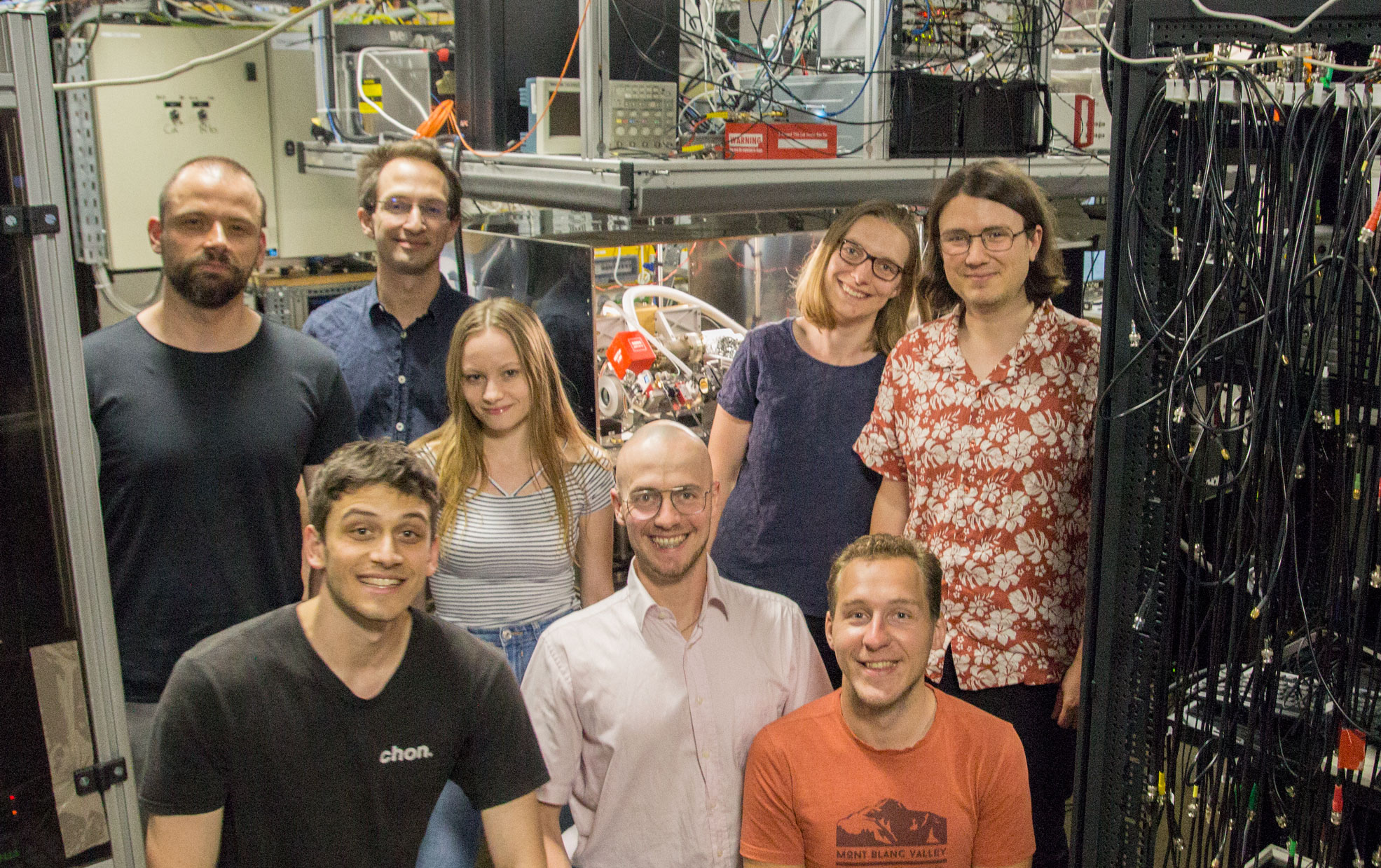
Qudits team, May 2024
- Markus Siegl (Student Assistant)
- Timo Spalek (Master Student)
- Raphael Poloczek (Master Student)
- Lisa Parigger (Master Student)
- Michael Meth (PhD Student)
- Tim Gollerthan (PhD Student)
- Peter Tirler (PhD Student)
- Manuel John (PhD Student)
- Keshav Pareek (PhD Student)
- Lukas Gerster (Postdoc)
- Martin Ringbauer (Principal Investigator)
Former Members: Claire Edmunds
- Details
Simulating 2D Spin Lattices with Ion Crystals
Analog quantum simulation with trapped ions in Innsbruck
In Innsbruck an analog quantum simulator based on 1D strings of Calcium-40 ions stored in a linear Paul trap is already used successfully to study systems of interacting spins with up to ~20 particles. In the approach used here and several other groups around the world, a spin-half particle is encoded into two electronic states of a trapped ion, which is manipulated via laser pulses: coherent single-ion operations and measurements are combined with engineered spin-spin interactions mediated by the motional modes of the ion crystal to directly implement e.g. Ising-type Hamiltonians in the system.
Why extend the system into the second dimension?
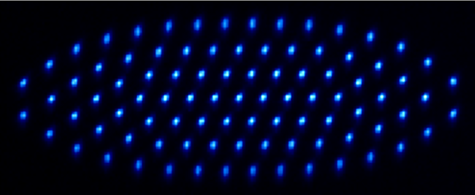
91 ion crystal in our setup
Scaling up an ion chain to a large number of particles (>50) presents a challenging task as extremely anisotropic trapping potentials are required to keep the ion crystal linear, leading to issues such as high heating rates of the axial motional modes as well as problems in addressing outer ions in long strings. In our approach of using 2D ion crystals, such problems can be circumvented, which will enable us to scale our quantum simulator up to 100 particles.
Our approach
The objective of this project is to experimentally realize a 100-particle quantum simulator with complete quantum control at the single-particle level. We combine the proven methodology for realizing spin models in linear ion crystals stored in radio-frequency traps with an idea of extending such a system into two dimensions, thus enabling studies of 2D non-equilibrium physics with a larger particle number.
The centerpiece of our setup is a novel monolithic linear Paul trap, which allows us to create the anisotropic potentials required for trapping 2D ion crystals while also being able to maintain sufficient optical access for imaging as well as single-ion addressing.
Our main experimental goals
- Trapping and laser-cooling of two-dimensional ion crystals to millikelvin temperatures in a radio-frequency trap.
- Realization of quantum spin models with particle numbers for which the simulation becomes intractable by numerical techniques.
- Development of methods for validating quantum simulators.
- Investigation of various models with spin-frustration in two-dimensional geometries.
Project members
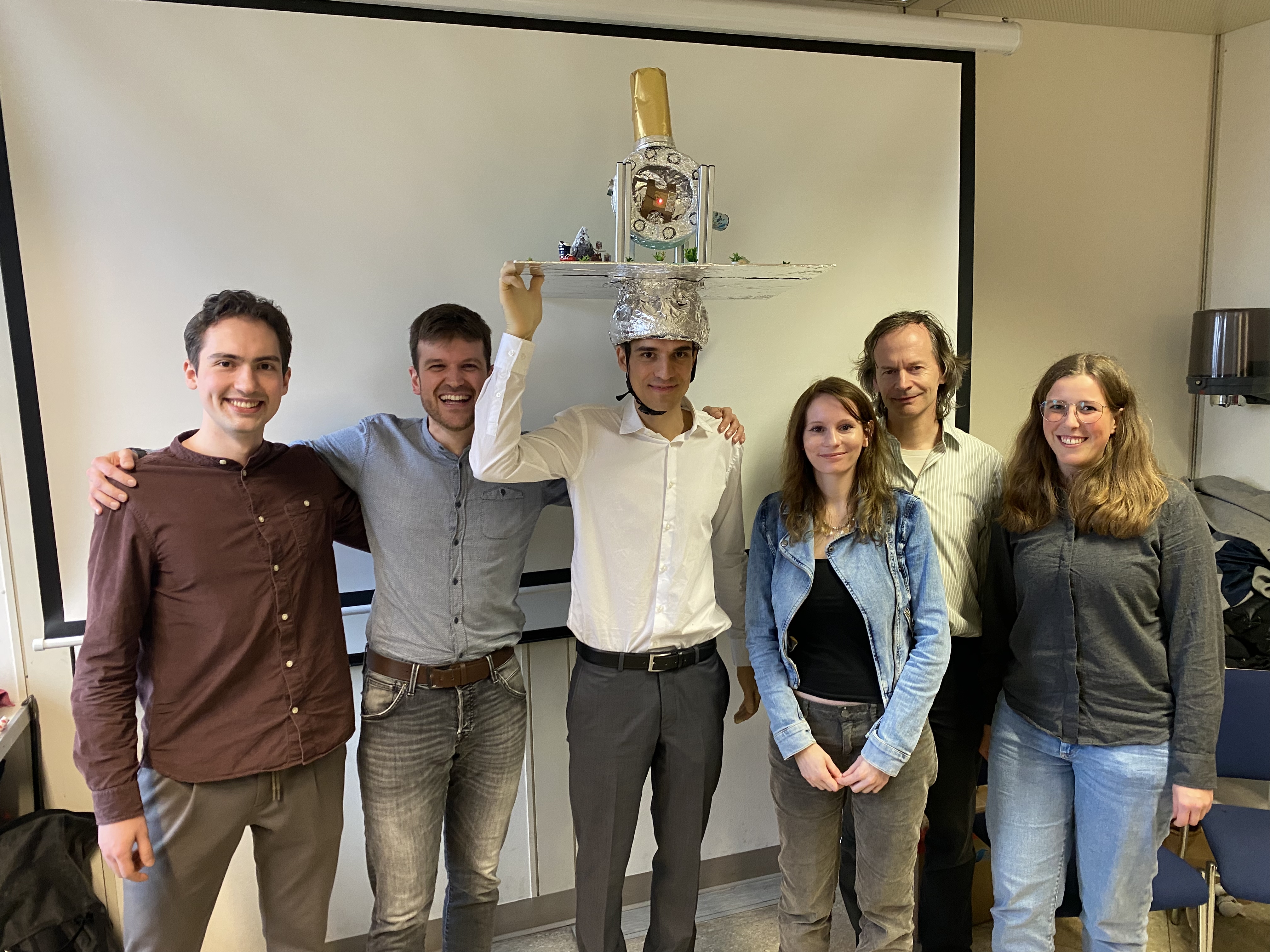
Team at Dominik's defence
- Christian Roos (Project Leader)
- Matthias Bock (Postdoc)
- Artem Zhdanov (PhD Student)
- Leo Walz (PhD Student)
- Nele Griesbach (Master Student)
Former members: Dominik Kiesenhofer, Helene Hainzer, Tuomas Ollikainen
If you are interested in joining our team, please
Publications and preprints
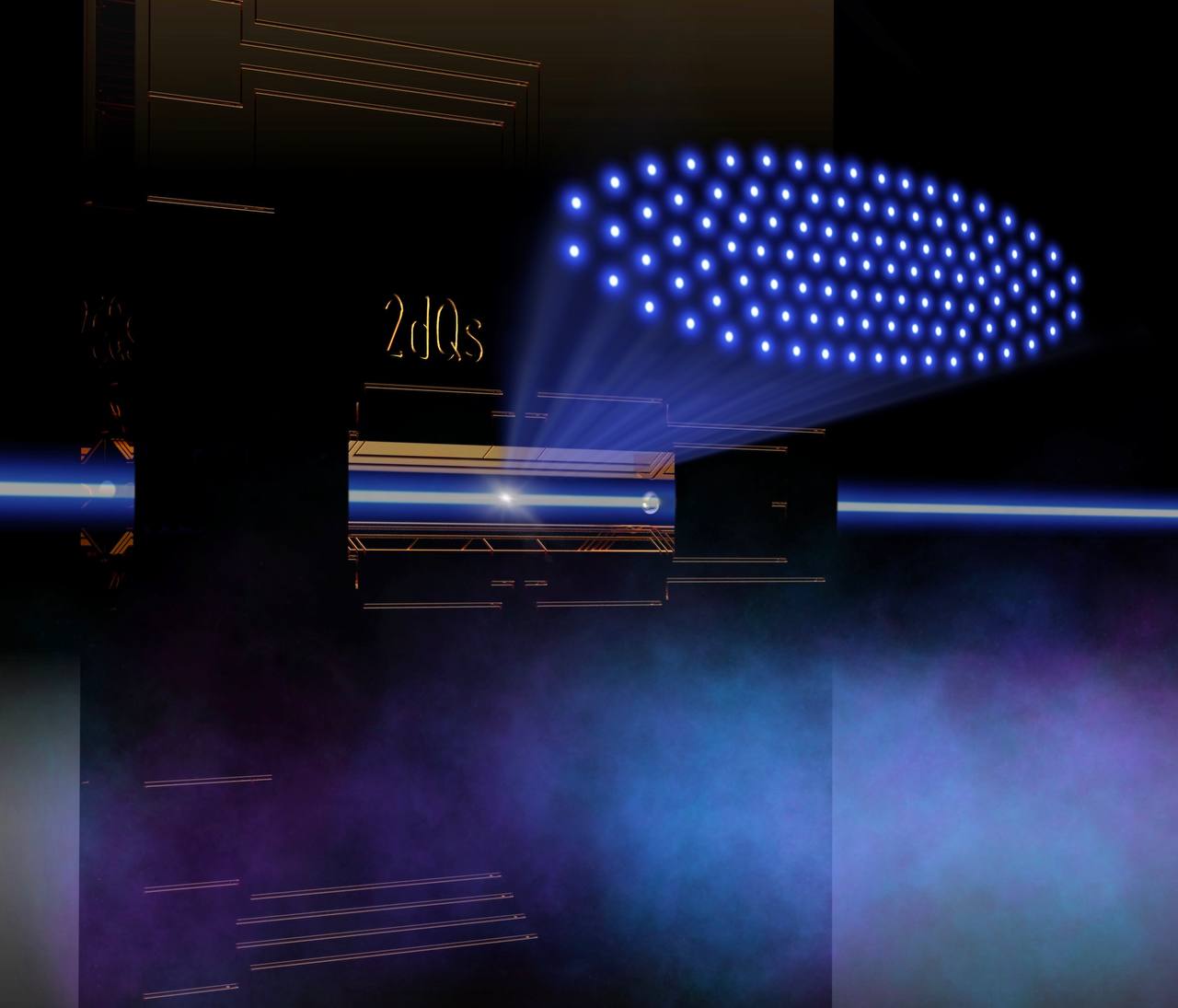
- Correlation spectroscopy with multi-qubit-enhanced phase estimation (Phys. Rev. X 2024) (arXiv)
- Sideband thermometry of ion crystals (PRX Quantum 2023) (arXiv)
- Controlling two-dimensional Coulomb crystals of more than 100 ions in a monolithic radio-frequency trap (PRX Quantum 2023) (arXiv)
- Polarization-gradient cooling of 1D and 2D ion Coulomb crystals (New J. Phys. 2020) (arXiv)
Funding
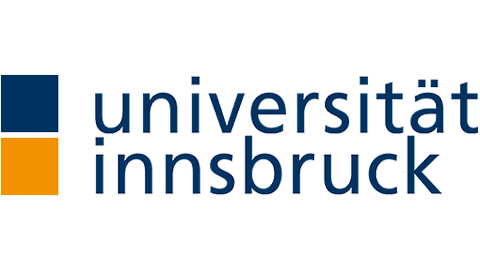
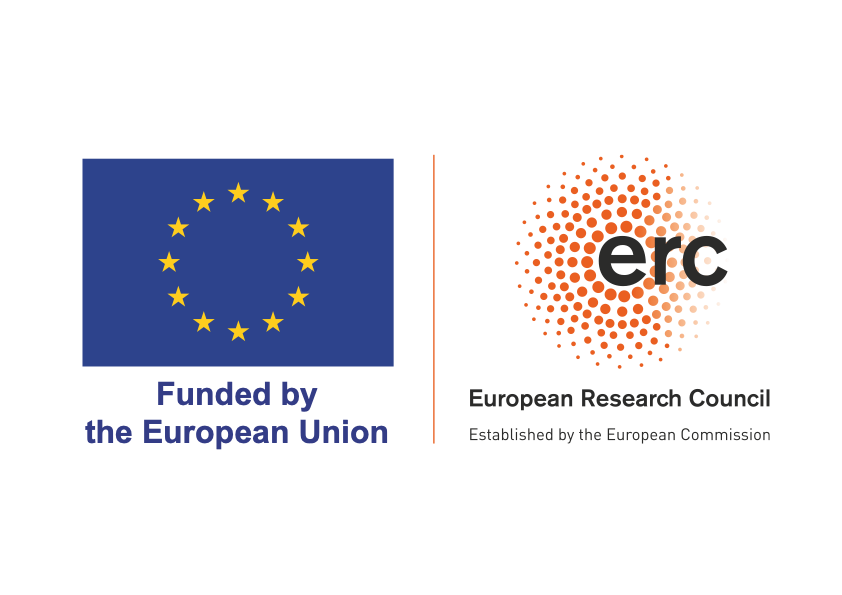



- Details
Quantum Information Processing
Trapped ions were arguably the first experimental platform to be used as quantum information processors and for almost 25 years our group has worked at the foundations of this now sprawling field. In this quarter century the group has grown steadily and now hosts several information processors with different focuses, register sizes, and form factors. Along with this growth in size and number of processors comes the breadth of principal research directions. These research topics include:
- Quantum error correction and fault tolerance - How can we make quantum computation tolerant to errors?
- Quantum characterisation, verification and validation - How can we make sure the output of a quantum computation is trustworthy?
- Qudits as higher-dimensional quantum information carriers – How can we make good use of quantum information carriers beyond limiting ourselves to two levels (qubits)?
- Scalable quantum information processor development – How do we build ever larger quantum computers and how to we operate and maintain them?
Over the years our research has been graciously supported by a great many projects, including:
- The EU programmes AQTION, MILLENION, PIEDMONS
- World-wide collaborations such as LogiQ, QCPR, and LASCEM
- National excellence funding such as the FWF SFB BeyondC
An ion trap-based quantum computer
In our experiments we make use of a combination of static and dynamic electric fields to trap and cool singly-charged atoms (ions) of Calcium-40 in ultra-high vacuum. Upon laser cooling these ions freeze into stationary structures called ‘ion crystals’ that behave much like a solid. We most frequently shape these crystals into strings in what has since come to be known as the linear Paul trap. These strings form the registers which we use for quantum information processing. While Paul traps can now come in many shapes and sizes, the archetype of a so-called macroscopic trap in quantum information processing is still the blade trap (see Fig 1.).
The excellent quantum control that is possible in these naturally identical quantum information carriers, qubits, has allowed our group to spearhead many developments and demonstrations from early breakthroughs such as Cirac-Zoller gate (Nature 422, 408–411 (2003)), or quantum teleportation of the state of an atom (Nature 429, 734–737 (2004)), the first quantum byte (Nature 438, 643–646 (2005)) to recent achievements such as large-scale, full-register, full-connectivity entanglement up to 26 qubits (PRX Quantum 2, 020343 – 2021) or the first universal logical quantum gate set (Nature 605, 675–680 (2022)) for quantum error correction.
 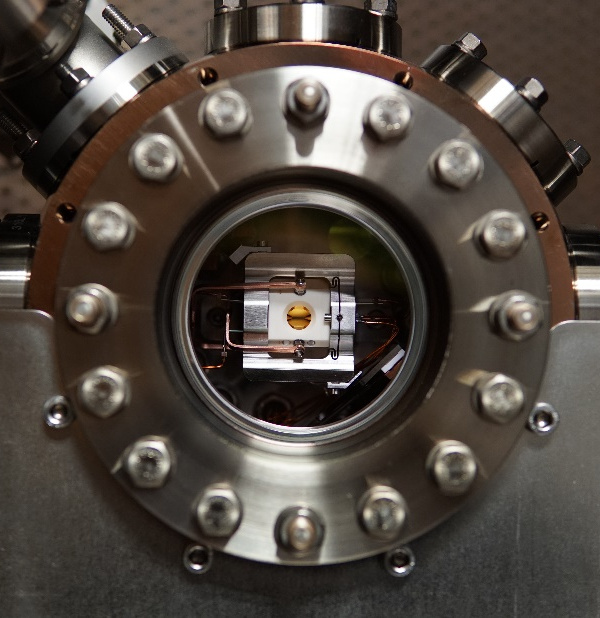 |
| Fig 1.: Left: The ‘Linear trap’ original blade trap in use for two decades. Right: The modern successor trap AQT PINE as used in the AQTION setup. |
Quantum error correction and fault tolerance
The state of quantum systems that may be used for powerful information processing tasks is notoriously fragile. Information we want to store and process is ever at the risk at being entangled with our hot and noisy environment which leads to computational errors. There is no known way to both perfectly isolate quantum information from this detrimental environment while at the same time still being able to manipulate it in any way. Consequently, just like in classical computation, we have to deal with errors. Unfortunately, classical computers are much more resilient against this occurring and the majority of classical error correction schemes are forbidden by the famous no-cloning theorem and collapse of the wavefunction upon measuring.
Fault tolerance and, as its tool, quantum error correction are attempts at still being able to perform arbitrary quantum computation by making use of redundant encoding of information over several physical information carriers.Logical information is stored non-locally such that an error at a single location does not destroy the distributed information, but can be recovered from the ensemble. Quantum error correction based on such collective “undoing” of local errors is difficult and essential. It is therefore considered to be the holy grail of quantum computing. As part of world-wide collaborations our group has been working on experimental error correction protocols and implementations for more than a decade:
Experimental Repetitive Quantum Error Correction Science (2011) Vol 332, Issue 6033 pp. 1059-1061
Quantum computations on a topologically encoded qubit Science (2014) Vol 345, Issue 6194 pp. 302-305
Experimental deterministic correction of qubit loss Nature volume 585, pages 207–210 (2020)
Entangling logical qubits with lattice surgery Nature volume 589, pages 220–224 (2021)
Demonstration of fault-tolerant universal quantum gate operations Nature volume 605, pages 675–680 (2022)
Our recent development focus is now shifting towards larger error correcting codes and performing the first error-corrected quantum algorithms.
Quantum characterisation, verification and validation
The prospect of a quantum computer so powerful that it outperforms even the biggest classical supercomputer is perhaps the greatest motivation for the development of quantum information processors. However, the question arises of how we make sure that the output of such a powerful machine is actually correct once they can no longer be checked by classical computers. How can we trust a powerful quantum machine to not be plain wrong or even maliciously manipulated when we cannot check the result anymore? In quantum characterisation, verification and validation (QCVV) our group has been working on routines and techniques which are supposed to achieve just this task for example by posing the same question to many machines and cross-checking (Phys. Rev. X 11, 031049 – 2021), demonstrating efficient tomographic methods (PRX Quantum 3, 040310 – 2022), or by using post-quantum secure classical means (arXiv:2203.07395 [quant-ph]).
Scalable quantum information processor development
The prospect of working with single quantum systems such as individual atoms and ions was something that the forefathers of quantum mechanics found exceedingly unlikely. However, today control over individual quantum systems is well established. For useful quantum information processing we require many such carriers of quantum information. However, larger registers bring new challenges that are not present when dealing with small numbers of quantum systems. Indeed, the very same reason why quantum computers are potentially powerful makes it also challenging to build larger ones. If the effort we need to expend to operate a quantum information processor grows just as quickly as its computational potential then we cannot reach a regime where they will outperform classical machines. That is to say we cannot need a super-classical machine to operate a super-classical machine. Keeping the resources needed to increase the computational power low is what is frequently referred to as ‘scalability’.
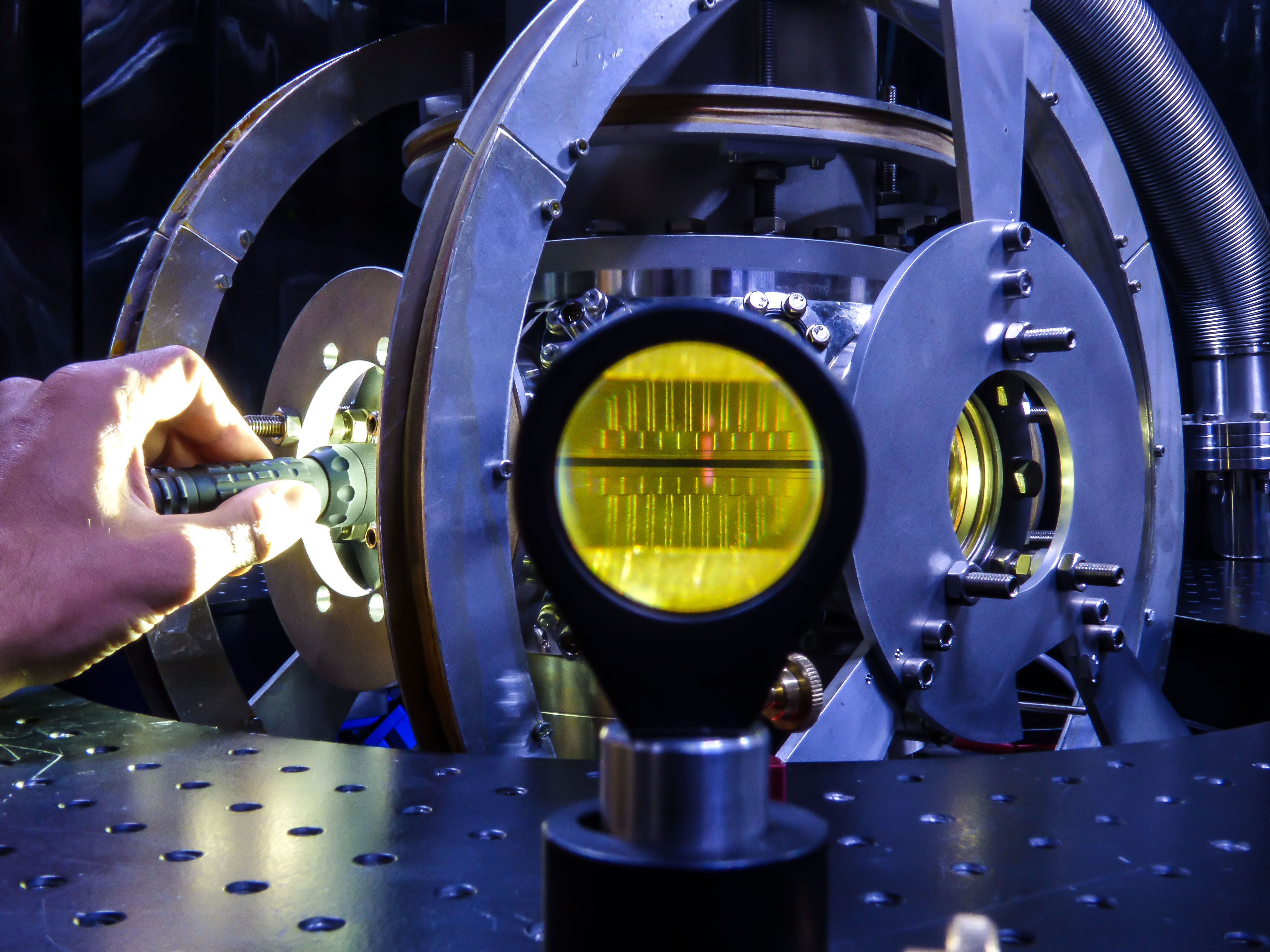 |
| Fig. 2: Segmented trap in Cryostat |
It is at this point fairly clear that linear ion chains stored in a single potential well as registers are not scalable. For one, if we aim for millions of qubits, that would require a vacuum chamber much larger than any reasonable person would want to have. Scalable trap architectures, their development and figuring out the ins and outs of how to use them is therefore an integral part of learning how to scale up quantum computers. Micro-structured, segmented traps and 2D trap structures are being investigated in our group in multiple setups (see Fig. 2). In such structured traps new operations are both possible and necessary for novel computational paradigms, which require excellent control over the motion of individual ions or subgroups of them. These operations include shuttling of ions, as well as splitting and merging of subgroups, or swapping of places between individual ions.
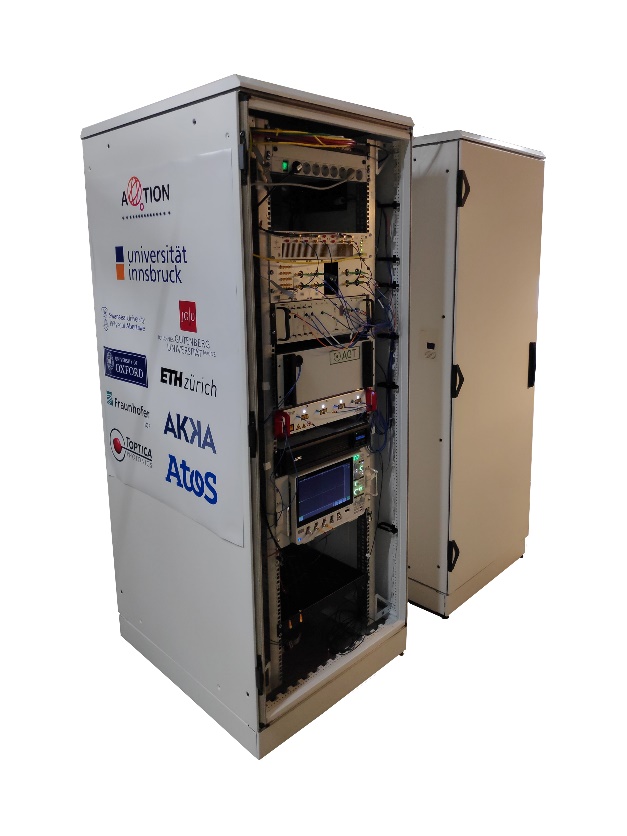 |
| Fig 3. Quantum Computer in 19'' Rack |
Scalable quantum information processors are a major research direction around the world. However, it is often the case that only individual parts or components of this large-scale endeavour are investigated by research groups. Our group has been part of the AQTION collaboration to figure out what exactly it takes to make a larger quantum processor work. Integrating all components and making them all work together in tandem, reliably, turns out to be a huge task. This is in part due to the fact that routines or techniques that work fine for smaller registers become absolutely unmanageable once register sizes grow past 10 or so qubits.
The 19’’-rack-based quantum computer developed and deployed within AQTION (see Fig 3.) has taken a big step towards realizing quantum computers that can operate reliably with large registers with form factor and operating conditions compatible with computing centres of classical computers (PRX Quantum 2, 020343 – 2021).
With development steadily progressing we are moving forward to the next generation of experimental setups. Gate errors, chiefly entangling gate errors, are still the dominant error source in quantum computers. In the Hyperion experiment we will be focusing on improving existing entangling gate schemes and developing and testing novel schemes to reach fundamental gate infidelities in the 10 parts-per-million range for single qubit, and 100 parts-per-million for entangling operations. Part of this will be achieved by switching from Calcium-40 to Barium isotopes such as Barium-137 which offers some key advantages over Calcium. Not the least of which is that the laser wavelengths required to interact with Barium offer themselves more readily to integrate optics directly into the ion traps to further drive scalability and stability. Moving to an isotope with nuclear spin I = 3/2 further offers, in contrast to Calcium-40, the option to use very stable hyperfine groundstate qubits.
The Quantum Information team is always looking for master’s, PhD students and postdocs! Do not hesitate to inquire with our principal investigator, Thomas Monz (
Project Members
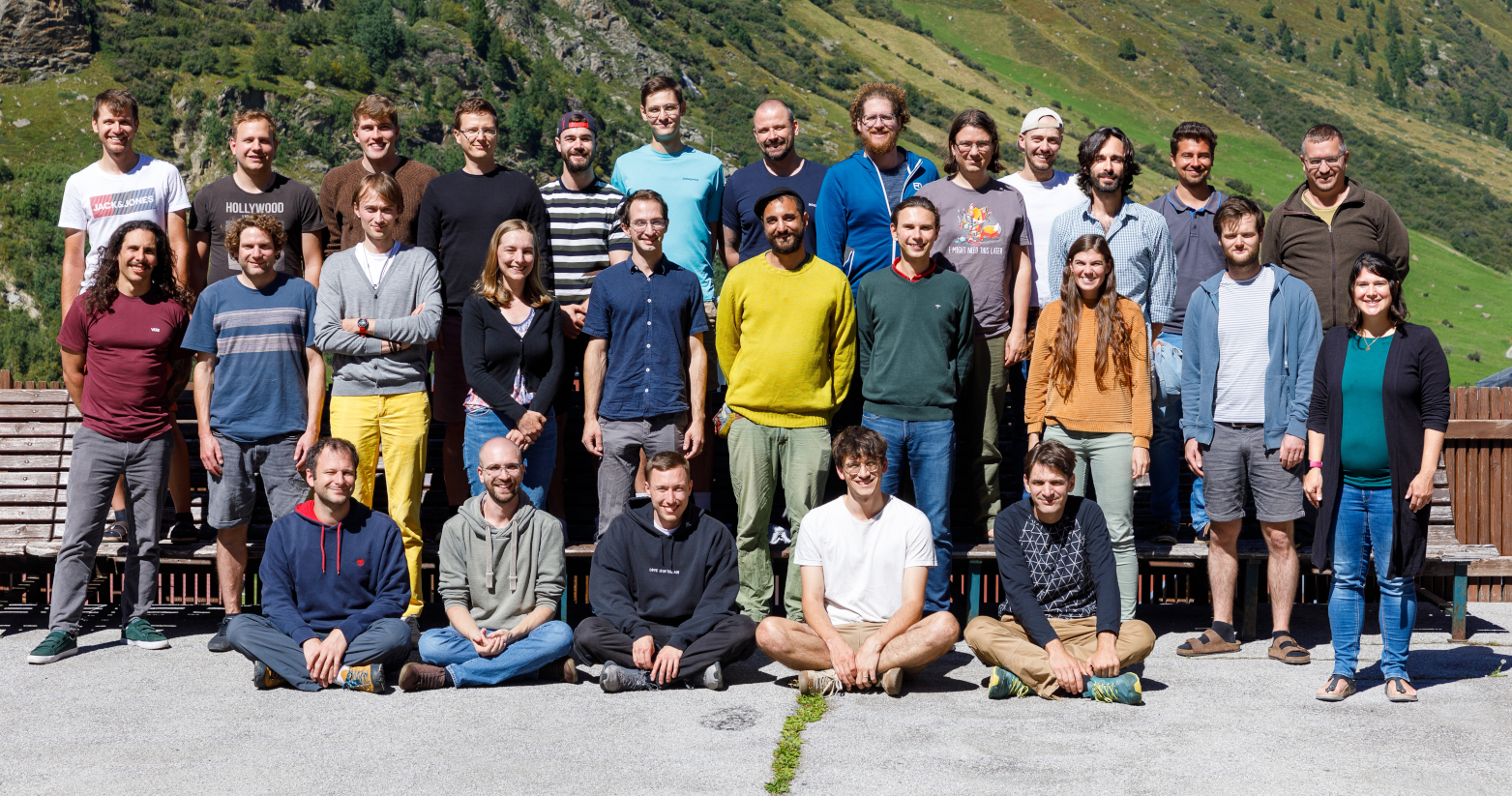
- Florian Kofler (Master Student)
- Tommaso Faorlin (PhD student)
- Lukas Gerster (PhD student)
- Manuel John (PhD student)
- Michael Meth (PhD student)
- Ivan Pogorelov (PhD student)
- Lukas Postler (PhD student)
- Lorenz Panzl (PhD student)
- Roman Stricker (PhD student)
- Peter Tirler (PhD student)
- Claire Edmunds (Postdoc)
- Christian Marciniak (Postdoc)
- Martin Ringbauer (senior scientist)
- Thomas Monz (senior scientist)
- Philipp Schindler (senior scientist)
- Rainer Blatt (group leader)
Former members: Julio Barreiro, Michael Chwalla, Stefan Quint, Rafael Rothganger de Paiva, Virgile Andreani, Anton Nolf, Daniel Nigg, Matthias Brandl, Esteban Martinez, Julian Rickert, Marc Bussjäger, Pavel Hrmo, Thomas Feldker, Alexander Erhard, Verena Podlesnic, Benjamin Wilhelm, Markus Teller, Martin van Mourik
- Details
Distributed Quantum Systems
In our group we work on developing methods to establish entanglement between remote quantum systems and using that capability to realize new scientific and technological applications. Our remote quantum systems are equivalent to registers of spins, in which entanglement can be stored and processed, that are linked together using photons. We would like to develop such quantum networks over distances from a few meters, in order to study scalable many-body quantum systems, up to thousands of kilometers, for global quantum communication and sensing networks. Our key research questions are:
- How can we distribute, store and grow entanglement between remote locations?
- What are the most promising applications of distributed entanglement and how can we realize them in the near future?
In our lab we focus on developing spin registers encoded into arrays of trapped atomic ions. The singularly-ionized atoms are held in a radio-frequency linear Paul trap. Each atom encodes a quantum spin, or quantum bit, and universal quantum processing can be realized over the spin register using laser-driven interactions. An optical cavity integrated around the trap allows for efficiently interfacing the spins with single photons. The image below shows our cavity-integrated ion-trap. We also develop non-linear optical systems for interconverting the wavelengths of photons from ion-compatible values to the special value of 1550nm. This `Telecom C-band’ wavelength is used by the global classical telecommunications industry, suffers minimal loss whilst travelling through optical fibers and is the ideal value for a future quantum communication standard.
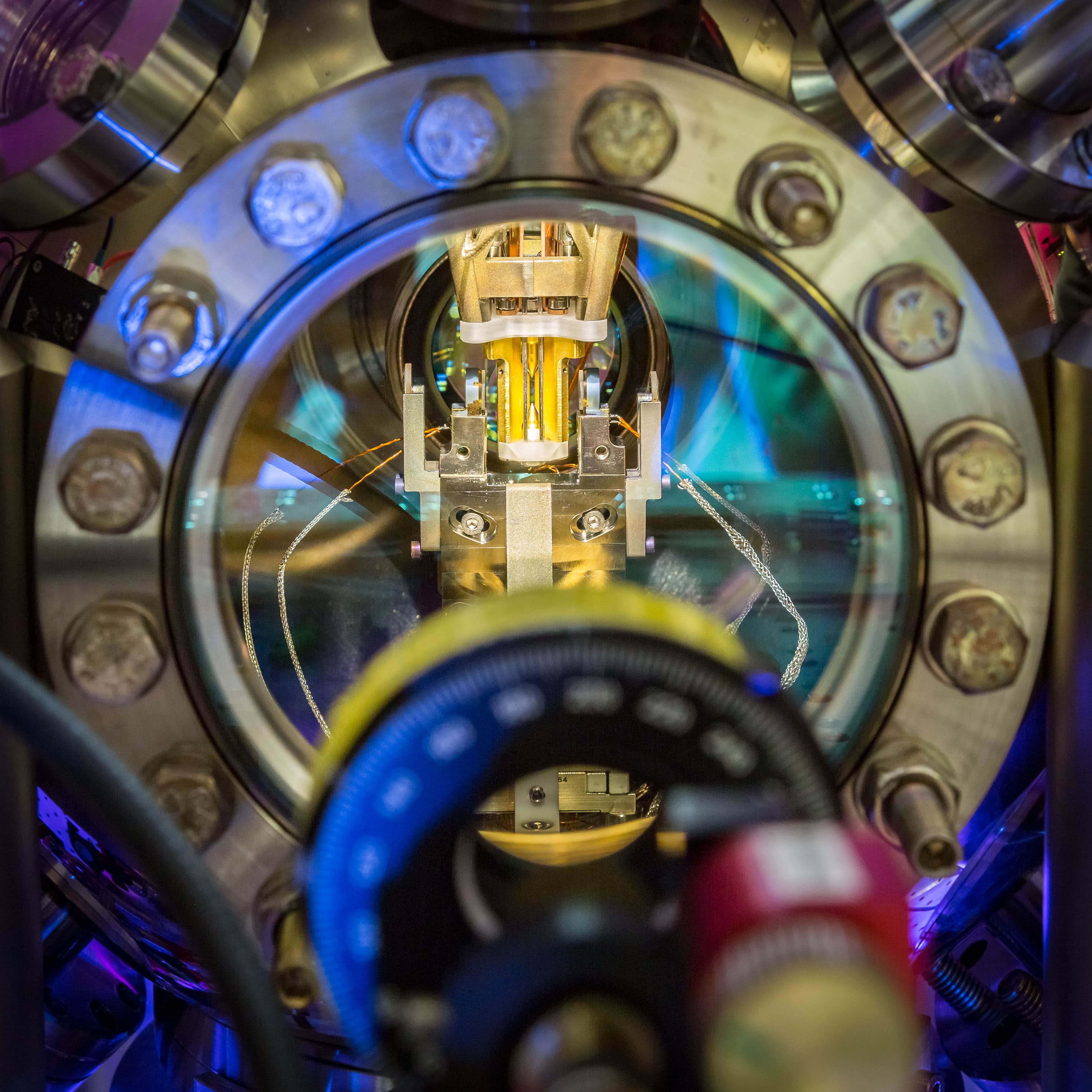
View into the vacuum chamber. The ion trap is made of gold-coated titanium electrodes and is attached to the top of the vacuum chamber. The optical cavity is formed by two mirrors in bluish titanium holders and sits on piezo stacks for cavity length control (the four wires supplying voltage to the piezos are visible). The cavity is attached, via translation stages (not shown), to the bottom vacuum chamber flange.
Recent news
- Apr 2024. We have PhD and Postdoc positions available. Please email us directly at
This email address is being protected from spambots. You need JavaScript enabled to view it. - Apr 2024. Our paper on multimode light-matter entanglement over 100km was published in PRX Quantum, here. An overarticle was written in Physics.
- Jun 2023. There has been quite some press about our repeater node paper. e.g., this viewpoint in Physics, this article in Optica and this article in Physics World.
- May 2023. Our repeater node paper was published in Physical Review letters, here.
- Feb 2023. Our paper on realizing a quantum repeater node [arXiv:2210.05418] was accepted for publication in Physical Review letters.
- Feb 2023. Our paper on entangling two ions in remote buildings was published in Physical Review letters. This work was carried out in close collaboration with the groups of Prof. Tracy Northup and of Prof. Nicolas Sangouard. Congratulations to the teams! Phys. Rev. Lett. 130, 050803 (2023) and arXiv:2208.14907 (see press release and editor's choice article).
Our Team
From left to right: Back row: Felix Bernecker, Tatjana Runggaldier, James Bate, Viktor Krutianskii, Armin Winkler, Ben Lanyon, Marco Canteri; Front row: Fabitha Kodakkat, Yash Wath, Pascal Wintermeyer
Former project members
Tabea Stroinski (Master), now at the University of Mainz, AG Schmidt-Kaler
Vojtech Krcmarsky (PhD), now at BERNARD group
Johannes Helgert (Master), now at the University of Amsterdam
Dr. Zhe Koong (Postdoc), now at the University of Oxford
Dr. Martin Meraner (PhD), now at BERNARD group
Dr. Josef Schupp (PhD), now at Alpine Quantum Technologies
Helene Hainzer (Master Student), now in the group of Ch. Roos
Dr. Muir Kumph (Postdoc), now IBM Watson Research Centre
Contact
Our new labs are on the 1st floor of the Viktor-Franz-Hess Haus, building TE025 on the Technik campus of the University of Innsbruck. Technikerstrasse 25, A-6020 Innsbruck, Austria.
Tel: +43-512-507-52900
Preprints
Experimental distributed quantum sensing in a noisy environment
J. Bate, A. Hamann, M. Canteri, A. Winkler, Z. Koong, V. Krutyanskiy, W. Dür, and B.P. Lanyon
arXiv preprint arXiv:2501.08940 (2025)A photon-interfaced ten qubit quantum network node
M. Canteri, Z. Koong, J. Bate, A. Winkler, V. Krutyanskiy, and B.P. Lanyon
arXiv preprint arXiv:2406.09480 (2024)
Publications
Multimode Ion-Photon Entanglement over 101 Kilometers
V. Krutyanskiy, M. Canteri, M. Meraner, V. Krcmarsky, and B.P. Lanyon
PRX Quantum 5, 020308 (2024)A telecom-wavelength quantum repeater node based on a trapped-ion processor
V. Krutyanskiy, M. Canteri, M. Meraner, J. Bate, V. Krcmarsky, J. Schupp, N. Sangouard, B. P. Lanyon
Phys. Rev. Lett. 130, 213601 (2023) (arXiv:2210.05418)Entanglement of trapped-ion qubits separated by 230 meters
V. Krutyanskiy, M. Galli, V. Krcmarsky, S. Baier, D. A. Fioretto, Y. Pu, A. Mazloom, P. Sekatski, M. Canteri, M. Teller, J. Schupp, J. Bate, M. Meraner, N. Sangouard, B. P. Lanyon, T. E. Northup
Phys. Rev. Lett. 130, 050803 (2023) and arXiv:2208.14907 (see press release and editor's choice)Interface between Trapped-Ion Qubits and Traveling Photons with Close-to-Optimal Efficiency
J. Schupp, V. Krcmarsky, V. Krutyanskiy, M. Meraner, T.E. Northup, and B.P. Lanyon
PRX Quantum 2, 020331 (2021)Indistinguishable photons from a trapped-ion quantum network node
M. Meraner, A. Mazloom, V. Krutyanskiy, V. Krcmarsky, J. Schupp, D. A. Fioretto, P. Sekatski, T. E. Northup, N. Sangouard, and B. P. Lanyon
Phys. Rev. A 102, 052614 (2020)Light-matter entanglement over 50 km of optical fibre
V. Krutyanskiy, M. Meraner, J. Schupp, V. Krcmarsky, H. Hainzer & B. P. Lanyon
npj Quantum Information, volume 5, Article number: 72 (2019)Deterministic quantum state transfer between remote qubits in cavities
B. Vogell, B. Vermersch, T. E. Northup, B. P. Lanyon, C. A. Muschik
Quantum Sci. Technol. 2 045003, arXiv:1704.06233
- "Polarisation-preserving photon frequency conversion from a trapped-ion-compatible wavelength to the telecom C-band"
V. Krutyanskiy, M. Meraner, J. Schupp and B. P. Lanyon
Appl. Phys. B 123, 228 (2017) (Open access) - "Quantum repeaters based on trapped ions with decoherence-free subspace encoding"
M. Zwerger, B. P. Lanyon, T. E. Northup, C. A. Muschik, W. Dür and N. Sangouard
Quantum Sci. Technol.2 (2017),arXiv:1611.07779
Theses
PhD
- Martin Meraner, A photonic quantum interface between trapped ions and the telecom C-band, 2022, Download
- Josef Schupp, Interface between trapped-ion qubits and travelling photons with close-to-optimal efficiency, 2022, Download
- Vojtech Krcmarsky, A trapped-ion quantum network over 230 m, 2024, Download
Master
- Helene Hainzer, Laser locking for trapped-ion quantum networks, 2018, Download
- Marco Canteri, Single-atom-focused laser for photon generation and qubit control, 2020, Download
- Armin Winkler, Frequency Stabilization of a 729 nm Ti:Sa Laser for Qubit Manipulation in Trapped Calcium Ions, 2023, Download
- Tabea Stronski, Implementation of a Controlled-NOT Gate with Quantum Memory Application for Trapped Ions, 2024, Download
- Johannes Helgert, Radio frequency control of a trapped-ion quantum network node, 2024, Download
